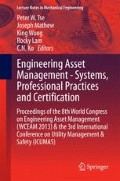Abstract
Ultrasonic Lamb wave inspection is one of nondestructive testing approaches, and it has many advantages including large-area, omnidirectional, fast inspection. In common, narrow-band frequency sinusoidal tone burst signal modulated by window function is used to excite guided waves in waveguides for mode control and tuning. For obtaining the signals at different frequencies, guided wave inspection will need to be repeated many times. As an alternative of narrow-band guided waves excitation, a broadband chirp signal is used for excitation signal and the received signal is post-processed to obtain any one single frequency tone burst signal which frequency range is located in the frequency bandwidth. This approach greatly increases guided waves inspection efficiency and ensures the consistencies. As the receivers, two PZT elements are supposed to be attached on both sides of a PMMA plate in the same location. The received signals from two PZT elements are summed to obtain single S0 mode, and are subtracted to obtain single A0 mode achieving mode purification of Lamb waves. Ultrasonic Lamb wave technology is applied to inspect the plate-like structures using chirp signal and mode purification. This method is more efficient and accurate to obtain data and much easier to identify, interpret and extract the information of the defects.
Access this chapter
Tax calculation will be finalised at checkout
Purchases are for personal use only
References
Michaels JE, Michaels TE (2007) Guided wave signal processing and image fusion for in situ damage localization in plates. Wave Motion 44:482–492
Zhao X, Roger L, Owens S et al (2011) Ultrasonic lamb wave tomography in structural health monitoring. Smart Mater Struct 20:105002(10)
Liu Z, Yu H, He C et al (2013) Delamination damage detection of laminated composite beams using air-couple ultrasonic transducers. Sci China: Phys, Mech Astron 56:1269–1279
Giurgiutiu V (2005) Tuned Lamb wave excitation and detection with piezoelectric wafer active sensors for structural health monitoring. J Intell Mater Syst Struct 16:291–305
Michaels JE (2008) Detection, localization and characterization of damage in plates with an in situ array of spatially distributed ultrasonic sensors. Smart Mater Struct 17:035035(10)
Liu Z, Yu F, Wei R et al (2013) Image fusion based on single-frequency guided wave mode signals for structural health monitoring in composite plates. Mater Eval 71:1434–1443
Wilcox P, Lowe M, Cawley P (2001) The effect of dispersion on long-range inspection using ultrasonic guided waves. NDT & E Int 34:1–9
Wilcox P, Dalton R, Lowe M (2001) Mode and transducer selection for long range Lamb wave inspection. J Intell Mater Syst Struct 12:553–565
Michaels JE, Lee S, Croxford A et al (2012) Chirp excitation of ultrasonic guided waves. Ultrasonics 53:265–270
Clarke T, Simonetti F, Rohklin S et al (2009) Development of a low-frequency high purity A0 mode transducer for SHM applications. IEEE Trans Ultrason Ferroelectr Freq Control 56:1457–1468
Clarke T, Cawley P (2010) Enhancing the defect localization capability of a guided wave SHM system applied to a complex structure. Struct Health Monit 10:247–259
Su Z, Ye L (2004) Selective generation of Lamb wave modes and their propagation characteristics in defective composite laminates. J Mater: Des Appl 218:95–110
Zheng Y, He C, Wu B (2013) Chirp signal and its application in ultrasonic guided wave inspection. Chin J Sci Instrum 34:552–558 (in Chinese)
Alleyne D, Cawley P (1992) Optimisation of Lamb wave inspection techniques. NDT & E Int 25:11–22
Acknowledgments
This work was supported by the National Natural Science Foundation of China (Grant Nos. 11272021 and 50975006), Beijing Natural Science Foundation (Grant No. 1122007), the Importation and Development of High-Caliber Talents Project of Beijing Municipal Institutions (No. CIT&CD201304048) and Beijing Nova Program (Grant No. 2008A015).
Author information
Authors and Affiliations
Corresponding author
Editor information
Editors and Affiliations
Rights and permissions
Copyright information
© 2015 Springer International Publishing Switzerland
About this paper
Cite this paper
Liu, Z., Xu, Y., He, C., Wu, B. (2015). Lamb Waves Inspection by Using Chirp Signal and Mode Purification. In: Tse, P., Mathew, J., Wong, K., Lam, R., Ko, C. (eds) Engineering Asset Management - Systems, Professional Practices and Certification. Lecture Notes in Mechanical Engineering. Springer, Cham. https://doi.org/10.1007/978-3-319-09507-3_14
Download citation
DOI: https://doi.org/10.1007/978-3-319-09507-3_14
Published:
Publisher Name: Springer, Cham
Print ISBN: 978-3-319-09506-6
Online ISBN: 978-3-319-09507-3
eBook Packages: EngineeringEngineering (R0)

